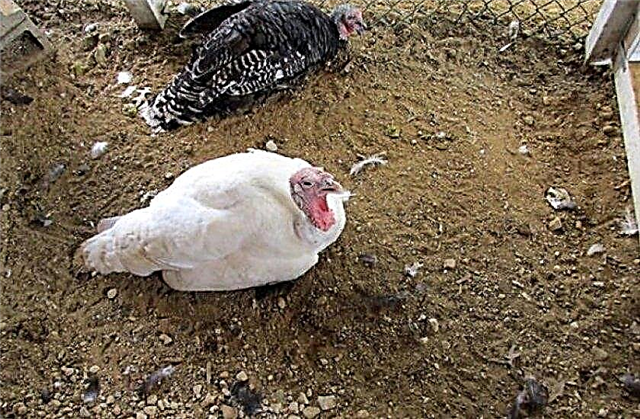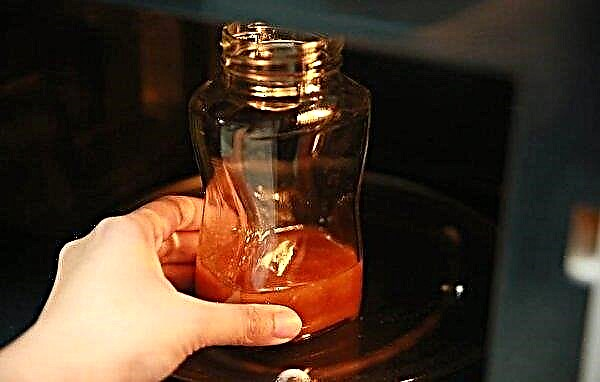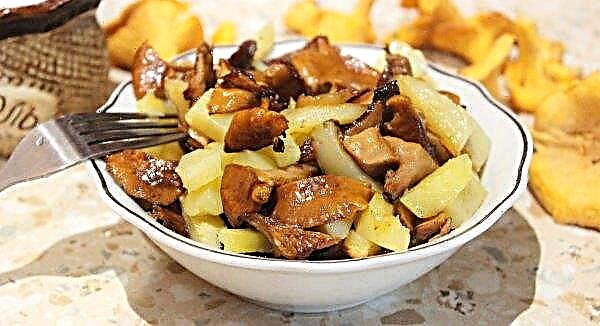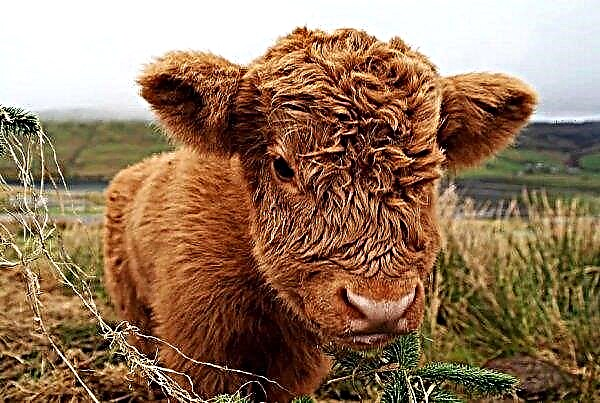Even the most caring owners can not always avoid the diseases of their poultry. From the article you will learn about the causes of falling on the legs of young turkeys and how to treat diseases with such a symptom.
The causes of the disease
A symptom of death on the legs is characteristic of several diseases that are directly associated with non-communicable diseases of the extremities, such as arthritis and rheumatism, and infectious ailments.
Also, this phenomenon can be observed in birds that live in conditions that do not meet the standards. Consider the main reasons in detail.
Diseases of the legs and joints
One of the common causes of death of birds on their feet is diseases of the limbs and joints. Usually they are manifested only by problems with walking and do not have other symptoms, for example, indigestion, changes in plumage, fever, etc.
Did you know? Turkey is one of the largest domesticated birds after ostriches. In 1998, representatives of the Guinness Book of Records registered the weight record among their relatives - a turkey named Tyson, who lives in the UK, reached a weight of 39.09 kg.
Arthritis
This ailment develops when birds are fed a large amount of protein. As a result, the limbs are deformed, movements cause feathered pain, turkeys just sit on their feet, not trying to move. It is important to pay attention to the problem in a timely manner, since in the advanced stage the disease leads to the death of birds.
Symptoms
- joint swelling;
- lack of motor activity;
- lameness;
- curvature of the extremities (in an advanced stage).

Treatment recommendations:
- Correct the bird menu, leading to normal intake of protein foods and adding vitamins D, B.
- Conduct antibiotic therapy. Ampicillin is usually used for treatment. It is mixed with food for 3-5 days.
- From folk remedies, internal use of mumiyo (0.4 mg / 100 g weight) is used. It is also rubbed into sore joints.
Rheumatism
Joint inflammation, or rheumatism, provokes errors in nutrition and maintenance. Most often, it manifests itself when birds live on damp litter, a cold floor, and the presence of drafts in the house. The disease develops very quickly.

Symptoms
- limping;
- decreased activity;
- refusal of movement;
- oppression.
Treatment recommendations:
- Bringing the conditions of detention back to normal.
- Carrying warm foot baths from nettle broth for 7 days.
- Oral administration of an aqueous solution of mumiyo (0.5 g / 1 kg of weight).
Other diseases
Turkeys also do not get on their feet due to other ailments, among which there are many deadly. With their development in birds, other symptoms are also observed, on the basis of which the specialist can make an accurate diagnosis.
Important! Diseases in turkeys are usually rapid, therefore, at the first symptoms, even with slight lameness, you should put the bird in a quarantine room and seek the advice of a veterinarian.
Newcastle disease
Leg cases are characteristic of such a dangerous viral disease as Newcastle disease, or pseudo-plague. It is excited by viruses that lead to damage to the nervous and digestive systems. It is transmitted through infected litter, feed, equipment, from rodents, sick birds. Between 60 and 90% of cases are fatal.
Symptoms
- refusal of food;
- increase in body temperature;
- lethargic state;
- motionless state;
- copious discharge from the nose, eyes, beak;
- coughing, sneezing;
- green feces diarrhea;
- staggering while walking;
- paralysis of the neck and legs;
- exhaustion.
 The disease is not amenable to treatment. It can only be prevented by timely vaccination of young animals.
The disease is not amenable to treatment. It can only be prevented by timely vaccination of young animals.Typhoid fever
Another dangerous viral disease is typhoid or pullorosis. It is transmitted through food, water, equipment, infected birds. Mortality is 70%.
Symptoms
- diarrhea of white color;
- depressed state;
- impaired coordination of movements;
- lack of hunger;
- drooping wings.
- Patients are not treated, they are killed.
- Healthy individuals who were in contact with patients need antibiotics of the tetracycline group in combination with sulfonamide drugs. Most often administered Furazolidone, Furaltodon.
- Carrying out preventive measures: proper nutrition, maintaining hygiene in the house, vaccination.
Synovitis
This disease affects both adults and young individuals who are 1.5–2 months old. It causes joint inflammation and immobilization of birds.
Symptoms
- swelling of the joints;
- Slow movement
- depressed state;
- lameness;
- pallor of the skin;
- softening of the joints.

Treatment recommendations:
- The introduction of drugs: Terramycin, Streptomycin, Biomycin, Gallimycin, Baytril, Tilan.
- Correction of norms of maintenance and feeding.
Postnatal pullorosis
Characteristic for small turkey poults. It is manifested primarily by their constant sitting position.
Symptoms
- digestive upset;
- oppression;
- impaired coordination of movements;
- refusal of food.
- Like regular pullorosis, postnatal is not treatable. Poultry will need to be rejected and scored.
- In contact with individuals without symptoms of the disease, sulfanilamide antibiotics are administered for the purpose of prevention, antimicrobials - Biocin, Vitabiomycin, Terramycin, Furazolidone.

- Disinfect the room.
Infectious bursitis
Viral disease, the causative agent of which settles in the lymphoid tissue. It develops within 7–9 days.
Symptoms
- watery diarrhea of white color;
- oppression;
- exhaustion;
- ruffled plumage;
- tremor of limbs;
- enlarged liver.

Treatment recommendations:
- Culling sick birds.
- Compliance with general sanitary and veterinary standards.
- Vaccination
- Exposure of newly arrived quarantined birds.
Marek's disease
The causative agent of this disease is the herpes virus. It affects the lymphoid and nervous systems. Transmitted from bird to bird. The disease poses a serious threat to livestock.
Symptoms
- unnatural movement;
- incorrect location of the paws;
- paresis, paralysis of the limbs;
- sagging wings;
- drooping of the head and curvature of the neck;
- difficulty breathing
- exhaustion.

Treatment recommendations:
- The disease is not treatable.
- Since chickens are most often susceptible to it, turkeys should not be kept in the same room with other poultry in order to prevent it.
- Healthy individuals need to be vaccinated.
Inappropriate Content
Turkeys are sensitive to living conditions. They do not tolerate cold, damp, sudden changes in temperature, react poorly to dirt and improperly organized feeding.
Quite often, birds, especially turkeys, have their legs twisted due to such errors:
- House overpopulation. For a comfortable stay of birds, they need to be settled no more than 2 adults per 1 sq. Km. m and no more than 4–5 turkey poults under the age of 3 months per 1 square. m. In close conditions, birds sit a lot, which means that their musculoskeletal system develops with disabilities.
- Lack of walks. Violations in the formation of the skeletal system in young animals occur due to an immobile lifestyle.
- Failure to comply with hygiene standards. The house should be washed, dried and disinfected before the birds are populated and after slaughter. Disinfection of premises and equipment is carried out with lime (2.8 kg / 10 l of water). During the growing process, it is necessary to monitor the dryness and cleanliness of the litter.
- Calcium deficient feed. For this reason, the skeleton of young animals does not develop correctly, the bones are weak, thinned, can not withstand the entire body weight.
- Excessive feeding of foods high in fats, vitamin A, soy and corn.
All the above reasons can lead to the fact that weakened parents give birth to inferior offspring with weak ligaments. It is for this reason that recently born turkeys are parted.Did you know? Baked turkey is a traditional Christmas dish for residents of many countries. So, in Greece it is served in wine, in the UK - with gooseberry sauce, in France - with chestnuts, cognac and cream, in the USA - with cranberry sauce. It is also obligatory on the table during the main winter holiday among Armenians and Irish.
Prevention of ailments
In order to prevent death on turkey legs, it is important to observe preventive measures:
- Vaccinate birds regularly.
- Properly draw up a diet so that it includes all the necessary vitamins and minerals.
- Adhere to a diet and do not overfeed birds.
- Observe sanitary and hygienic standards and maintain at the required level temperature, humidity, air velocity during ventilation. Keep turkeys up to three months of age at a temperature of at least 28 degrees.
- In the period from the 20th to the 25th day, young animals are fed with ASD 2 - it helps to strengthen the immune system.
- To strengthen the immune system, Chiktonik is also given (1 ml / 1 liter of water) twice a day for 5–7 days.
- Conduct regular inspections of the livestock in order to detect sick birds in time, quarantine them and proceed with treatment.
- From a week old, add vitamin D (1 g / 1 liter of water) to the turkey poultry menu. It is given from the 8th to the 10th day, and then from the 50th day.
- Make sure that only fresh feed gets into the bird feeder.
Thus, turkeys can fall on their feet for many reasons - from the development of a serious disease to errors in content. It is important to notice the problem in time, establish the cause and eliminate it. In order for the birds to get sick less often, it is necessary to apply preventive measures and give them vitamin preparations that strengthen the immune system.Important! If it is not possible for you to independently calculate the norms and the number of ingredients in the diet, you should seek the help of a veterinarian. He will advise how to create a balanced daily menu for the summer and winter periods specifically for your breed of turkeys.













